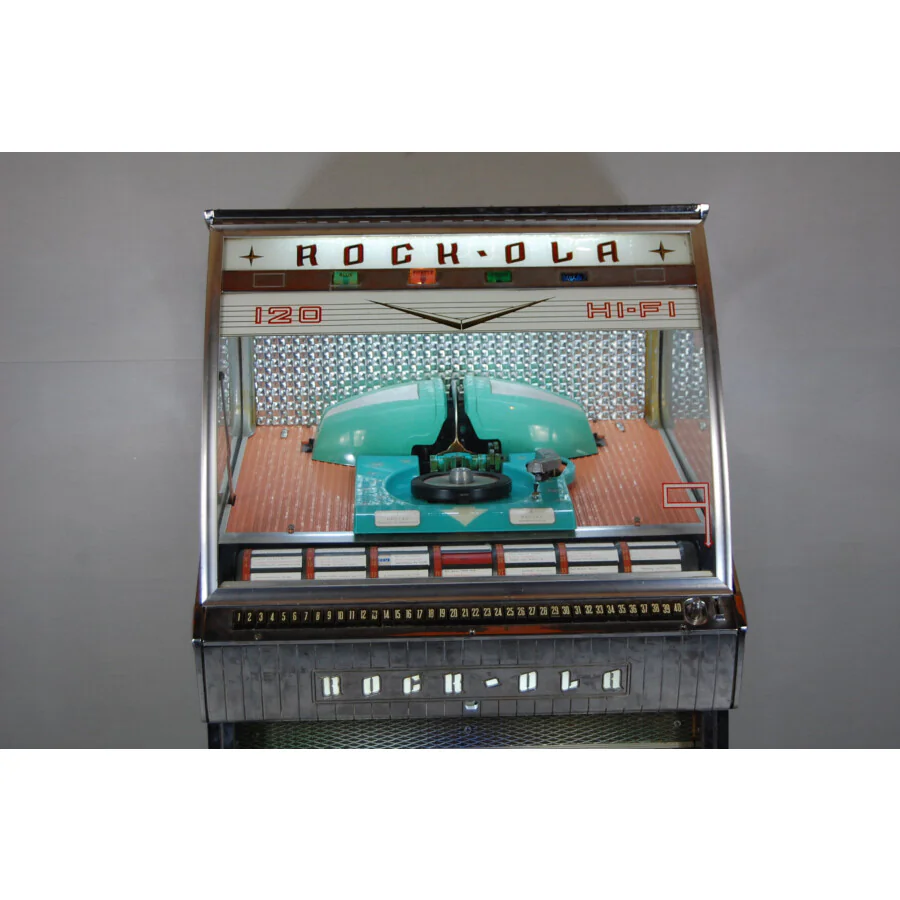Introduction
In the pantheon of musical machines, few devices capture the imagination quite like the jukebox. These coin-operated marvels, which brought music to diners, bars, and arcades, were more than mere playback devices—they were cultural icons, blending technology, art, and nostalgia. Among the many jukeboxes produced over the decades, one stands out as the most elaborate of all time: the Rock-Ola 1458 Symphonola, introduced in 1957. This masterpiece of engineering and design pushed the boundaries of what a jukebox could be, combining cutting-edge technology, opulent aesthetics, and a level of mechanical complexity that remains unmatched. This article delves into the history, design, technological innovations, cultural impact, and lasting legacy of the Rock-Ola 1458 Symphonola, exploring why it deserves the title of the most elaborate jukebox ever created.
Historical Context: The Golden Age of Jukeboxes
To understand the significance of the Rock-Ola 1458 Symphonola, we must first place it within the context of the jukebox’s golden age. The 1950s were a transformative period for jukeboxes. Post-World War II prosperity fueled a surge in entertainment technology, and jukeboxes became fixtures in American social spaces. Companies like Wurlitzer, Seeburg, AMI, and Rock-Ola competed fiercely to produce machines that were not only functional but also visually spectacular, reflecting the optimism and exuberance of the era.
Rock-Ola, founded by David C. Rockola in 1927, had established itself as a major player in the jukebox industry by the 1950s. Known for its innovative designs and reliable mechanisms, Rock-Ola sought to outdo its competitors with the 1458 Symphonola, a machine that aimed to redefine the jukebox as both a technological marvel and a work of art.
Design: A Symphony of Chrome and Light
The Rock-Ola 1458 Symphonola was a visual spectacle, embodying the flamboyant aesthetic of the 1950s. Standing over five feet tall and weighing nearly 300 pounds, the Symphonola was a commanding presence in any room. Its design was a celebration of mid-century modern style, characterized by bold lines, vibrant colors, and an almost futuristic flair.
Exterior Aesthetics
The Symphonola’s cabinet was crafted from high-quality wood, finished with a polished veneer that gave it a luxurious sheen. The front of the machine was dominated by a massive, curved glass panel that showcased its internal mechanisms, inviting onlookers to marvel at its complexity. Chrome trim adorned every edge, reflecting light in a dazzling display that screamed sophistication. The grille, made of intricately patterned metal, featured a starburst design that became a hallmark of Rock-Ola’s premium models.
Perhaps the most striking feature was the Symphonola’s lighting system. Multi-colored neon tubes and incandescent bulbs created a kaleidoscope of hues that pulsed in time with the music, a feature that was revolutionary for its time. The lighting was not merely decorative—it was programmed to synchronize with the rhythm of the selected track, creating a proto-visualizer effect that captivated audiences. This integration of light and sound elevated the Symphonola from a mere jukebox to a multi-sensory experience.
User Interface
The user interface of the 1458 was equally elaborate. The selection panel featured a grid of 120 pushbuttons, each corresponding to a specific record. These buttons were backlit with translucent plastic, glowing in soft pastel shades that complemented the machine’s overall aesthetic. Above the buttons, a rotating title strip mechanism displayed the names of available songs, with each strip illuminated for easy reading in dimly lit environments. The coin slot, accepting nickels, dimes, and quarters, was seamlessly integrated into the chrome-plated control panel, ensuring both functionality and style.
Technological Innovations: Engineering Marvels
The Rock-Ola 1458 Symphonola was not just a pretty face—it was a technological tour de force. At a time when most jukeboxes were limited to 40 or 50 selections, the Symphonola offered an unprecedented 120 selections, accommodating 60 vinyl records (with A and B sides). This capacity required a level of mechanical ingenuity that set the Symphonola apart from its contemporaries.
The Record-Changing Mechanism
At the heart of the Symphonola was its record-changing mechanism, a marvel of precision engineering. Unlike earlier jukeboxes that used simple stack-and-play systems, the 1458 employed a complex carousel system. Records were stored in a circular magazine, which rotated to align the selected disc with the tonearm. A series of gears, cams, and levers—driven by a powerful electric motor—retrieved the record, placed it on the turntable, and returned it to its slot after playback. This process was not only reliable but also remarkably fast, with a selection-to-play time of under 10 seconds.
The tonearm itself was a masterpiece of design. Equipped with a dual-stylus cartridge, it could play both 33⅓ and 45 RPM records, a feature that was cutting-edge for the time. The tonearm was counterbalanced to minimize wear on the records, and its movement was controlled by a series of microswitches that ensured pinpoint accuracy. This level of precision was critical, as any misalignment could damage the delicate vinyl discs.
Sound System
The Symphonola’s audio system was equally impressive. It featured a high-fidelity amplifier paired with a 12-inch woofer and two 6-inch midrange speakers, delivering a sound quality that rivaled home hi-fi systems of the era. The machine also included a bass reflex enclosure, which enhanced low-frequency response and gave the music a rich, full-bodied sound. For venues with larger spaces, the Symphonola could be connected to external speakers, making it versatile enough for both intimate diners and sprawling dance halls.
Electrical Complexity
Powering this behemoth required an intricate electrical system. The Symphonola used a combination of vacuum tubes and early solid-state components, a transitional technology that bridged the gap between the tube-based systems of the 1940s and the fully transistorized jukeboxes of the 1960s. The machine’s wiring harness was a labyrinth of color-coded cables, meticulously arranged to prevent interference and ensure reliable operation. A built-in diagnostic system allowed technicians to troubleshoot issues using a series of indicator lights, a feature that was virtually unheard of in consumer electronics at the time.
Cultural Impact: A Symbol of the 1950s
The Rock-Ola 1458 Symphonola was more than a machine—it was a cultural phenomenon. Released at the height of the rock ‘n’ roll craze, it became a fixture in the places where youth culture thrived: diners, soda fountains, and juke joints. The Symphonola’s vast selection allowed it to cater to diverse musical tastes, from Elvis Presley and Chuck Berry to Nat King Cole and Frank Sinatra. Its presence in a venue signaled modernity and sophistication, drawing crowds eager to experience its visual and auditory splendor.
The Symphonola also played a role in shaping social dynamics. In an era before personal music players, jukeboxes were communal devices, sparking conversations and debates over song choices. The act of selecting a record on the Symphonola—punching a button and watching the intricate dance of its mechanisms—was a performance in itself, turning patrons into temporary DJs. The machine’s synchronized lighting added to the spectacle, making it a centerpiece of the 1950s nightlife scene.
Legacy and Collectibility
The Rock-Ola 1458 Symphonola was produced in limited numbers, with estimates suggesting fewer than 5,000 units were manufactured. Its high cost—approximately $1,500 in 1957 (equivalent to over $15,000 today)—made it a luxury item, reserved for high-end venues. As a result, surviving examples are rare and highly sought after by collectors.
Today, a fully restored Rock-Ola 1458 Symphonola can fetch upwards of $20,000 at auction, with pristine units commanding even higher prices. Collectors prize the machine for its rarity, beauty, and historical significance. Restoration is a painstaking process, requiring specialized knowledge of both the mechanical and electrical systems. Original parts are scarce, and many restorers rely on custom-fabricated components to bring these machines back to life.
The Symphonola’s influence can be seen in modern jukebox designs, particularly in the revival of retro-styled machines. Companies like Rock-Ola (which continues to produce jukeboxes) and others have drawn inspiration from the 1458’s blend of form and function, incorporating digital technology while preserving the nostalgic aesthetic of the 1950s.
Why the Rock-Ola 1458 Symphonola Stands Alone
So, what makes the Rock-Ola 1458 Symphonola the most elaborate jukebox of all time? It is the perfect synthesis of design, technology, and cultural impact. Its opulent aesthetics, with chrome, neon, and synchronized lighting, pushed the boundaries of what a jukebox could look like. Its mechanical complexity, with a 120-selection carousel and dual-speed tonearm, represented the pinnacle of 1950s engineering. And its role as a cultural icon cemented its place in history, embodying the spirit of an era defined by music, innovation, and optimism.
Other jukeboxes, such as the Wurlitzer 1015 “Bubbler” or the Seeburg Select-O-Matic, are celebrated for their beauty and innovation, but none match the Symphonola’s sheer ambition. The 1015, for example, is iconic for its bubble tubes and Art Deco styling, but its 24-selection capacity pales in comparison to the Symphonola’s 120. The Seeburg Select-O-Matic was a technological marvel, introducing the 100-selection jukebox, but it lacked the Symphonola’s synchronized lighting and visual flair. The Rock-Ola 1458 Symphonola combined the best elements of its competitors and took them to new heights, creating a machine that was as much a work of art as it was a functional device.
Conclusion
The Rock-Ola 1458 Symphonola is a testament to the ingenuity and creativity of the jukebox industry at its peak. Its elaborate design, groundbreaking technology, and cultural significance make it the most elaborate jukebox of all time. For those lucky enough to encounter a working Symphonola today, it offers a glimpse into a bygone era—a time when music was a shared experience, and machines like the Symphonola were the beating heart of social spaces. As both a technological marvel and a cultural artifact, the Rock-Ola 1458 Symphonola remains unmatched, a shining example of what happens when engineering meets artistry in perfect harmony.
Jukebox Buyer Resources
Jukebox Auctions – Vinyl Record Jukeboxes – CD Jukeboxes – Jukebox Records

